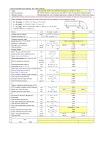
Contents :-
C H A P T E R 1 :- Refrigeration
C H A P T E R 2 :- Evaporators
C H A P T E R 3 :- Condensers
C H A P T E R 4 :- Compressors
C H A P T E R 5 :- Metering Devices
C H A P T E R 6 :- Controls and Accessories
C H A P T E R 7 :- Refrigeration System Troubleshooting
C H A P T E R 8 :- Compressor Motor Controls
C H A P T E R 9 :- Retrofitting, Recovery, Evacuation,and Charging
C H A P T E R 10:- Supermarket Refrigeration
C H A P T E R 11:- Walk-in Refrigerators and Freezers
C H A P T E R 12:- Ice Machines
C H A P T E R 13:- Product Temperatures for Preservation and Health
C H A P T E R 14:- Refrigeration Business Tips
A P P E N D I X
G LO S SA RY
I N D E X
Commercial Refrigeration for Technicians by Dick Wirz
This book is written for refrigeration technicians, air-conditioning (AC) technicians, and advanced AC students. Commercial refrigeration, as a specifi c subject, is taught in only about 10 percent of the schools that have HVACR programs. As a result, there are very few AC students or technicians exposed to this related technology.The industry certainly needs technicians trained in AC. However, if AC technicians also understand commercial refrigeration, they will be more valuable to their companies and their customers.
The subject matter and format of this book are the result of a 60-hour course I developed for the Washington, D.C., chapter of the National Association of Power Engineers (NAPE). Doug Smarte, executive director of the NAPE Education Foundation, recognized the need to offer training in commercial refrigeration to building engineers and property managers.
Organization
The first six of the fourteen chapters combine both a review of refrigeration theory and an introduction to how those principles are applied specifi cally to commercial refrigeration equipment. Wherever possible, refrigeration concepts are compared with those of AC. This makes it easier for HVACR students and technicians to relate what they already know to the fi eld of commercial refrigeration.Chapter 7 applies the information in the fi rst six chapters to the troubleshooting of nine common refrigeration system problems. It also includes a diagnostic chart for the reader to use in class, as well as on the job.
Chapter 8 on motor controls also has its share of troubleshooting instructions. The commercial refrigeration industry has been at the forefront of developing retrofi tting practices for replacing chlorofl uorocarbon (CFC) and hydrochlorofl uorocarbon (HCFC) refrigerants. Therefore, Chapter 9covers retrofi tting, along with the other related practices of recovery, evacuation, and
charging.
Chapter 10 is an introduction to the fascinating world of supermarket refrigeration.Chapters 11 and 12 deal with walk-ins, reach-ins, and ice machines. Chapter 13 is a relatively short but important look at the role of the refrigeration technician in food preservation and health issues.
Because many HVACR technicians eventually start their own companies, the last chapter in this book deals with the business side of this industry. Even if most students have no immediate intention of becoming self-employed, this chapter provides a glimpse of what their employers deal with on a daily basis. By gaining these insights, technicians can become a more supportive and vital part of their
organizations.









-page-001.jpg)


0 Comments